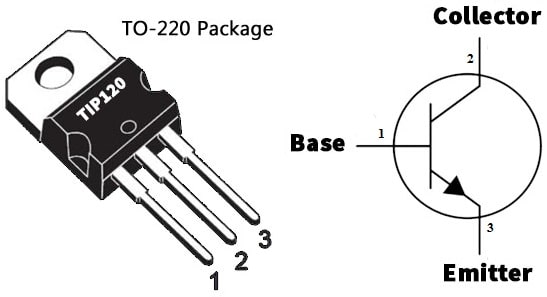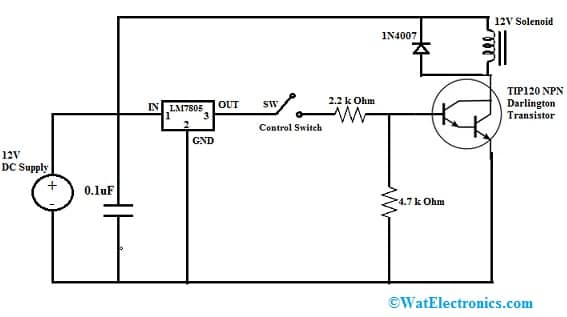A semiconductor device like a transistor is one of the basic building blocks within modern electronics mainly used for switching or amplifying electrical signals & power whereas the Darlington transistor has a multi-transistor configuration that performs like a single transistor that includes one base, emitter & collector. This Darlington configuration has a higher current gain as compared to every transistor taken independently. So it works & frequently packaged as a single transistor. There are many NPN Darlington transistors available in the market like MPSA13, TIP120, PZTA29, BD679, 2N5306, etc. This article discusses one of the types of NPN Darlington transistors like TIP120 NPN Darlington Transistor – pin configuration, specifications, and its applications.
What is TIP120 NPN Darlington Transistor?
The TIP122 is an NPN Darlington pair transistor. This transistor simply works like a typical NPN-type transistor, but it includes a Darlington pair. So the first transistor’s emitter terminal is connected to the second transistor’s base terminal and also the collector terminals of two transistors are connected to make a Darlington pair. This improves the current gain & current rating of transistors. Once the voltage is applied at the base terminal of this transistor then it gets biased & draws little current which is utilized for controlling huge currents at the collector & emitter terminals.
The TIP120 transistor has approximately 5A of high collector current rating & 1000 gain. This transistor can switch upto 60V loads with 8A of peak current. So this makes it to use in high-power & medium electronics like solenoids, high-power LEDs & controlling motors.
This transistor is used in a wide range of amplification & switching applications. To become completely saturated & also to drive 5A or 5000mA of a load, it needs only 120mA to its base terminals once used as a switch. By using 5A of current, an extensive range of components can be powered like LED strips, high-power LEDs high-power relays, LED bulbs, switches, a standalone device, or a complete circuit.
Pin Configuration:
The pin configuration of the TIP120 NPN Darlington Transistor with a symbol is shown below. This transistor includes three pins and each pin and its function are discussed below.

TIP120 NPN Darlington Transistor Pin Diagram
- Pin1 (Base): The base terminal of this transistor controls the transistor biasing, so it is used to control the transistor by turning ON/OFF.
- Pin2 (Collector): The collector terminal of this transistor allows the flow of current and it is usually connected to the load.
- Pin3 (Emitter): The emitter terminal drains out the current and it is generally connected to GND.
Features & Specifications:
The features and specifications of the TIP120 transistor include the following.
- It is a Medium-power NPN Darlington Transistor.
- The typical High DC Current Gain or hFE is 1000.
- Collector current or IC is 5A.
- The collector-Emitter voltage or VCE is 60V.
- A collector-Base voltage or VCB is 60V.
- Emitter Base Voltage or VBE is 5V.
- Base Current or IB is 120mA.
- The peak load current is 8A.
- It is available in To-220 Package.
- Junction Temperature or TJ ranges from -65 to +150 °C.
TIP120 NPN Darlington Transistor Circuit: Solenoid
The solenoid driver circuit using a TIP120 transistor is shown below. Solenoid is a loop of wire that is wrapped around a cylindrical core made of ferromagnetic material, such as iron. When an electric current is passed through the coils, it creates a magnetic field that is concentrated in the core. This magnetic field can be used to move a mechanical component, such as a plunger or valve, by attracting it towards the core. In this way it is used to change the electrical supply into linear motion. So this is the most expensive use of a loop of wire. The solenoid can be used as a switch of power thus, it requires the driver circuit. Here we are going to design a solenoid driver circuit that uses the TIP120 transistor.
The required components to make this solenoid driver circuit mainly includes 12V Solenoid, TIP120 NPN Darlington Transistor, 12V DC supply, IC 7805 voltage regulator, 1N4007 diode, 0.1µF capacitor, 2.2KΩ & 4.7KΩ resistors and switch.

Solenoid Driver Circuit using TIP120 Transistor
Working
The solenoid driver circuit is designed by using the above basic electronic components. In the above circuit, the TIP120 transistor needs the least base voltage. So IC 7805 voltage controller is utilized in this circuit to manage the input DC voltage.
Here, the input voltage supply applied to the solenoid is 12V. One end of the solenoid is connected to the collector terminal of the TIP120 NPN Darlington Transistor. The output of the IC 7805 voltage controller is connected to the base terminal of the TIP120 transistor using the control switch. Once the control switch is turned OFF, then the transistor will be turned OFF, so the solenoid used in the circuit does not get supplied. Similarly, once the control switch is turned ON, the transistor will turn ON due to the base-emitter voltage. Therefore solenoid coil gets supplied & works like an electromagnet.
The solenoid driver circuit using a TIP120 transistor is used in many applications like vending machines, remote access systems, and door-locking systems for offices, hotel making them a key component to be used in many types of electromechanical systems etc.
In a vending machine the solenoid driver circuit using TIP12o is used to
a. Control the dispensing mechanism: for example, when a user selects a product and makes a payment, the TIP120 can be used to activate a solenoid or motor that dispenses the product.
b. Monitoring the inventory: The TIP120 Transistor can also used to monitor the inventor by connecting the transistor to a sensor that detects when a product is dispensed, the vending machine can keep track of how many products are remaining and alert the operator when supplies are running low.
c. Controlling the lighting: When a user selects a product, this transistor can be used to turn on a light that illuminates the selected product.
Complement & Equivalent of TIP120 NPN Transistor:
The TIP120 complement transistor is the TIP125 transistor. The equivalent Tip120 transistors are: 2N6388, 2N6532, 2N6530, 2SD1191, 2N6044, TIP142T, BDW43, MJF122, 2N6045, MJF6388, 2N6045G, 2N6043, 2SD1026, TIP120, 2SD634, 2SD633, TIP101, BDT63B, TIP131.
How to Safely use TIP120 Transistor within a Circuit?
To obtain enduring performance through this transistor it is suggested not to operate any load above 60V & 5A. It must be confirmed pin configurations before connecting them within any application circuit. Always utilize an appropriate heatsink and also utilize an appropriate base resistor by this transistor. Do not store under the temperature < -65 C and above the temperature > +150 C.
Applications
The uses or applications of TIP120 NPN Darlington Transistor include the following.
- This transistor is applicable for low-speed switching & amplification.
- This transistor drives heavy loads.
- This transistor can be used with an Arduino board to turn on lights, drive motors & also drive high-power gadgets.
- It is utilized in different Microcontrollers.
- It is used in audio preamplifiers & their stages.
- It is used in driving & switching loads below 5A.
- It is used in audio amplifier stages circuits & audio power amplifier appliances.
- It can be utilized as a medium power switch.
- It is applicable where high amplification is required.
- It is used to control the speed of motors.
- It is used in rectifier & inverter circuits.
- This transistor is used in power management, signal processing, consumer electronics, portable devices, and industrial.
- TIP120 Transistors helps in controlling high-power devices using a microcontroller. So, please refer to this for Precautions to be taken while connecting a Transistor to Microcontroller.
Please refer to this link for the TIP120 NPN Darlington transistor Datasheet.
Please refer to this for How to Select a Transistor.
Thus, this is an overview of a TIP120 NPN Darlington transistor. The TIP120 NPN Darlington Transistor functions like a standard NPN transistor although since it has Darlington Pair in it provides up to 5A of good collector current & gain of above 1000. Here is a question for you, what is a Darlington transistor?